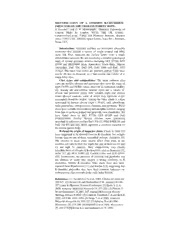
Identification of a Common R-Chondrite Impactor on the Ureilite Parent Body PDF
Preview Identification of a Common R-Chondrite Impactor on the Ureilite Parent Body
IDENTIFICATION OF A COMMON R-CHONDRITE IMPACTOR ON THE UREILITE PARENT BODY. H Downes1,2 and D W Mittlefehldt3. 1Birkbeck University of London, Malet St. London, WC1E 7HX UK. E-mail: [email protected]; 2Lunar and Planetary Institute, Houston Texas 77054 USA, 3Johnson Space Centre, Nasa Rd 1, Houston, Texas USA. Introduction: Polymict ureilites are brecciated ultramafic meteorites that contain a variety of single mineral and lithic clasts [1]. They represent the surface debris from a small, differentiated asteroid. We are continuing a detailed petrological study of several polymict ureilites including EET 87720, EET 83309 and FRO93008 (from Antarctica), North Haig, Nilpena (Australia), DaG 976, DaG 999, DaG 1000 and DaG 1023 (Libya). The latter four stones are probably paired. Clast sizes can be 10 mm in diameter, so a thin-section can consist of a single lithic clast. Clast types and compositions: The most common clast- types are ureilitic olivines and pyroxenes that cover the range of mg# (74-96) and Fe/Mn values observed in monomict ureilites [2]. Among the non-ureilitic mineral clasts are a variety of olivine and pyroxene grains with variable mg#s and distinct minor element contents, some of which may represent as-yet unsampled chondritic bodies. Among the lithic clasts is a type dominated by ferroan olivine (mg# = 59-65), with subordinate sodic plagioclase, orthopyroxene, chromite and pyrrhotite. These clasts have variable recrystallised metamorphic textures, ranging from fine to medium grained and generally lack chondrules. We have found them in EET 87720, EET 83309 and DaG 999/DaG1000. Similar ferroan olivines were previously described in polymict ureilites DaG 319 [3], FRO 93008 [4] and DaG 164 [5] and they likely represent a common impactor on the ureilite parent body. R-chondrite origin of impactor clasts: Clasts in DaG 319 were suggested to be derived from an R-chondrite, but oxygen isotope data on one of these resembled ordinary chondrites [6]. The olivines in these clasts clearly differ from those in the ureilites, not only in their low mg#s but also in their low Cr and Ca and high Ni contents. Their compositions very closely resemble those of olivines in R-chondrites such as Rumuruti [7], Acfer 217 [8], PCA 91002 [9], Carlisle Lakes and ALH 85151 [10]. Furthermore, the presence of chromite and pyrrhotite and the absence of metal also suggest a strong similarity to R- chondrites. Similar R-chondrite lithic clasts have also been reported from Weatherford [11] and Kaidun [12], suggesting that R-chondrite projectiles may have been common impactors on carbonaceous clan asteroids in the early Solar System. References: [1] Goodrich C A et al. 2004. Chemie der Erde 64, 283-327. [2] Downes H and Mittlefehldt D W. Abstract #1150 37th Lunar & Planetary Science Conference. [3] Ikeda Y et al. 2000. Antarctic Meteorite Research 13, 177-221. [4] Fioretti A M and Goodrich C A 2001. 64th Annual Meteoritical Society Meeting abstract # 5003. [5] Cohen B, Goodrich C A and Keil K 2004. GCA 68, 4249-4266. [6] Ikeda Y et al 2003. Antarctic Meteorite Research 16, 105-127. [7] Schulze H et al 1994. Meteoritics 29, 275-286. [8] Bischoff A et al 1994. Meteoritics 29, 264-274 [9] Rubin A E and Kallemeyn G W 1994. Meteoritics 29, 255-264. [10] Rubin A E and Kallemeyn G W 1989. Geochimica et Cosmochimica Acta 53, 3035-3044. [11] Prinz et al. 1993. Meteoritics 28, 419. [12] Zolensky M and Ivanov A 2003. Chemie Der Erde 63, 185-246.
